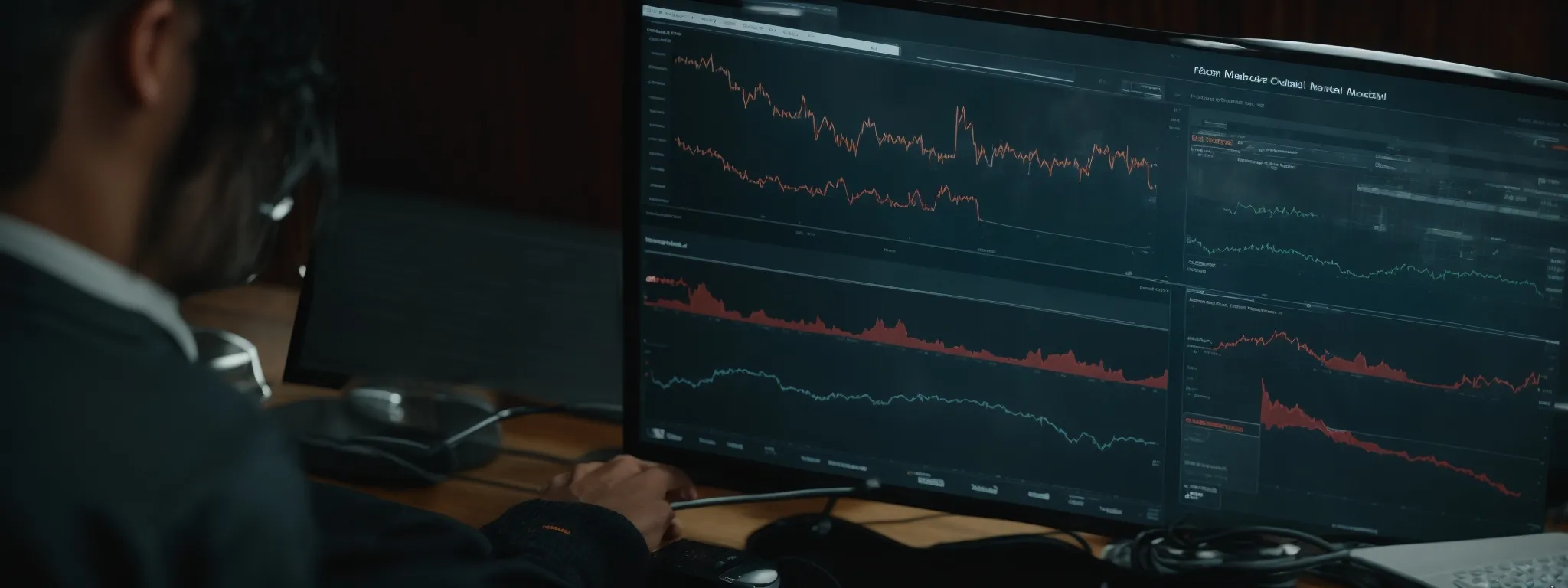Core Web Vitals
Maximizing Your Site’s Performance With Core Web Vitals Essentials In a digital landscape where user satisfaction is paramount to success, Core Web Vitals provide essential insights into […]
Maximizing Your Site’s Performance With Core Web Vitals Essentials
In a digital landscape where user satisfaction is paramount to success, Core Web Vitals provide essential insights into your site’s user experience metrics.
These vitals, vital components of the user experience, measure the quality of user interactions, from the loading responsiveness to the visual stability of a web page.
LinkGraph specializes in turning these performance data into actionable strategies that catapult web page rankings and enhance user engagement.
Businesses eager to thrive must prioritize these core metrics to stay competitive within the search results.
Keep reading to discover how LinkGraph’s SEO services can transform your site’s performance using Core Web Vitals.
Key Takeaways
- Core Web Vitals Are Crucial for Site Performance and Significantly Impact Google Search Rankings
- LinkGraph’s SEO Services Use Advanced Tools Like Search Atlas to Optimize and Monitor Core Web Vitals
- Enhancements in Core Web Vitals Can Lead to Increased Organic Traffic, Reduced Bounce Rates, and Higher User Retention
- Continuous Adaptation to Updates in Performance Metrics Is Essential for Maintaining a Competitive Edge in SEO
- Strategic Optimizations of Core Web Vitals Result in Improved Business Metrics and ROI for LinkGraph’s Clients
Understanding the Fundamental Core Web Vitals

In the dynamic terrain of Search Engine Optimization, where the digital pulse never stagnates, Core Web Vitals emerge as essential metrics that website owners cannot afford to overlook.
Pivotal in the grand schema of page experience, these vitals act as quality signals that directly influence how a site ranks in Google’s search results.
Comprising three pillars—Largest Contentful Paint (LCP), First Input Delay (FID), and Cumulative Layout Shift (CLS)—Core Web Vitals offer a quantifiable glimpse into the real-world usability of a webpage.
Discerning the impact these vitals have on user experience is crucial for any SEO professional or business owner looking to maintain an edge in an environment where mere seconds can dictate the balance between a bounce and a conversion.
What Are Core Web Vitals and Why They Matter
Core Web Vitals are a set of specific factors that Google considers important in a webpage’s overall user experience. These vital metrics include Largest Contentful Paint (LCP), which gauges loading performance; First Input Delay (FID), which measures interactivity; and Cumulative Layout Shift (CLS), which assesses visual stability.
Signaling the priority of user-centric benchmarks, Core Web Vitals form part of Google’s page experience criteria, a collective of factors aimed at delivering a more delightful web landscape. They matter because a website’s adherence to these metrics can significantly influence its positioning within search results, making them a cornerstone for SEO professionals like those at LinkGraph, who leverage insights to optimize site performance.
The Three Pillars of Core Web Vitals: LCP, FID, and CLS
The bedrock of Core Web Vitals lies in its three foundational elements: Largest Contentful Paint (LCP), First Input Delay (FID), and Cumulative Layout Shift (CLS). LCP is a critical metric that measures the time taken for the main content of a web page to load, highlighting the threshold by which the largest page element renders within the viewer’s viewport, a key factor contributing to how quickly users can absorb content.
FID addresses the responsiveness of a page by quantifying the period between a user’s first interaction and the browser’s response to that interaction. Meanwhile, CLS scores the sum of all layout shifts that occur unexpectedly during the lifespan of the page, providing a measure of the visual stability and how page elements shift, thus preserving a seamless user experience.
The Impact of Core Web Vitals on User Experience
Core Web Vitals are integral to site performance, directly influencing a user’s interaction with web pages. A high LCP score means faster load times and quicker access to valuable content, ensuring users remain engaged, while a lower score could lead to impatience and site abandonment. Fostering rapid interactivity and visual stability through optimized FID and CLS respectively, bolsters user satisfaction and could very well determine a site’s ability to retain a visitor’s attention.
A strong performance in Core Web Vitals not only contributes to an enhanced page experience but also serves as a potent Google ranking factor. With these metrics, LinkGraph’s SEO services underscore the importance of performance data and real user metrics (RUM) in crafting an optimal digital journey. They ensure that each web element contributes to a cohesive and interruption-free user experience, thereby Affecting a Website’s Authority and search presence.
Analyzing Your Site’s Core Web Vitals Performance

In the quest for digital supremacy, evaluating and enhancing a website’s Core Web Vitals is paramount to ensuring competitive performance in search rankings.
With a suite of diagnostic tools like LinkGraph’s Search Atlas SEO tool, site owners can conduct thorough analyses to pinpoint the precise factors affecting their website’s user experience.
Armed with these analytics, professionals can decipher Core Web Vitals reports to extract actionable insights and implement changes that propel a website’s performance.
Moreover, Industry Benchmarks serve as a navigational compass, setting a standard against which one can measure a site’s Core Web Vitals, furnishing a clear route to optimization and success.
Tools to Accurately Measure Core Web Vitals
LinkGraph utilizes an array of sophisticated tools, like the Search Atlas SEO tool, which meticulously gauges Core Web Vitals to furnish site owners with a detailed understanding of their web presence. This powerful solution delves into the intricacies of user experience, offering empirical field data to measure LCP, FID, and CLS, ensuring pinpoint precision in identifying areas of improvement.
The Chrome User Experience Report, another instrument in LinkGraph’s arsenal, taps into a broad spectrum of user data, gleaning vital information across various desktop and mobile devices. By harnessing user experience metrics from real-world conditions, it equips SEO professionals with the insights necessary to take a data-driven approach to webpage optimization and lifecycle management.
Interpreting Core Web Vitals Reports for Actionable Insights
Interpreting Core Web Vitals reports fuels the strategic initiative for website enhancement and aligns efforts with user expectations. LinkGraph’s SEO professionals, drawing on their expertise, meticulously dissect the nuances provided in these reports, translating complex performance data into tangible improvements that reinforce web presence and user satisfaction.
Cognizant of the interplay between Core Web Vitals and organic search performance, LinkGraph’s use of their Search Atlas SEO tool ensures each page element is scrutinized, allowing for the rigorous optimization of elements like rendering and interaction sequences. This focused analysis directly informs the refinement of load times, responsiveness, and visual stability, weaving together the tapestry of a superior user experience.
Benchmarking Your Site Against Industry Standards
Benchmarking against industry standards is a pivotal step in positioning a website to meet the high demands of today’s digital interactions. LinkGraph’s proficiency in comparing a customer’s Core Web Vitals with prevailing industry data guides site owners to calibrate their user experience properly, aligning with the expectations and usage patterns discerned from broader web performance trends.
Utilizing the Search Atlas SEO tool, LinkGraph aids businesses in understanding where their web page stands in comparison to the competition’s vitals metrics. This process reveals pivotal insights, prompting strategic enhancements that not only close the performance gap but carve out a superior niche for the client’s digital presence in the search results.
Strategies for Improving Loading Performance

Optimizing a website’s loading performance stands central to excelling in Core Web Vitals, with Largest Contentful Paint (LCP) serving as a critical indicator of how swiftly a site presents its main content.
In the competitive digital space, SEO experts and developers collaborate in deploying effective techniques that tackle loading inefficiencies, ensuring user retention through improved page experience.
These strategic tactics include prioritizing resource delivery to reduce time to first byte (TTFB) and embracing the innovative practice of lazy loading, both of which play a substantial role in elevating the user’s interaction with a web page.
LinkGraph’s SEO services identify and address these critical elements, enhancing a site’s user-centric performance metrics without sacrificing quality or visual appeal.
Techniques to Enhance Largest Contentful Paint (LCP)
Enhancing Largest Contentful Paint requires a meticulous approach to resource optimization: A technique that LinkGraph’s cadre of SEO specialists masterfully commands. With a focus on streamlined delivery, their strategies directly tackle the elements that contribute most significantly to lengthy load times.
- Minimization of CSS and JavaScript blocking resources, which accelerates page loading by reducing parsing and execution times.
- Employment of content delivery networks (CDNs) to facilitate faster delivery of content across global distances.
- Image optimization, including format selection and compression, to speed up the rendering time of visual content within the viewport.
By tactically deploying these optimizations, LinkGraph ensures the focal content of a webpage is presented to the user with remarkable alacrity. The commitment to refining LCP underscores an unwavering dedication to augmenting the user journey, thereby fostering a competitive edge in search rankings.
Prioritizing Resources for a Faster Loading Experience
In the pursuit of superior page performance, prioritizing resources effectively stands as a pivotal maneuver within the SEO terrain. Through intelligent deferment or asynchronous loading of non-critical resources, LinkGraph champions a methodology that places essential content at the forefront, thereby accelerating the moment of meaningful interaction for the user.
Furthermore, LinkGraph advocates for strategic script management, ensuring that vital scripts are loaded in a sequence that preserves the user’s ability to interact with the page without delay. By refining the order and manner in which resources are requested, they bolster the likelihood of achieving quicker page load speeds, directly enhancing a site’s user experience metrics and its overall digital footprint.
Implementing Lazy Loading for Off-Screen Images
Embracing lazy loading technology is integral for enhancing user engagement as it strategically defers the loading of images and other media until they are needed. Implementing this method reduces initial page load times, conserves bandwidth, and alleviates the burden on the user’s device, enabling a smoother browsing experience.
The adoption of lazy loading cultivates an environment where resources are allocated with precision; images enter the browser’s viewport only as a user scrolls through the content. LinkGraph’s skilled professionals integrate lazy loading as a key tactic to optimize Largest Contentful Paint (LCP), yielding a significant uptick in performance scores:
| Strategy | Benefit |
|---|---|
| Lazy Loading Implementation | Enhanced LCP |
| Resource Conservation | Bandwidth Efficiency |
| Deferred Image Loading | Faster Initial Page Load |
Optimizing Interactivity and Stability

In the quest to create a sterling digital experience, two vital considerations that demand attention are the fluidity of user input response and the solidity of visual presentation.
These elements are critical in optimizing First Input Delay (FID) and Cumulative Layout Shift (CLS), which are determinants of a site’s responsiveness and stability.
For SEO professionals with LinkGraph, enhancing these aspects means delving into techniques that reduce input delays and eliminate unexpected layout shifts, along with refining how JavaScript functions during a page’s lifecycle.
Acknowledging that seamless interactivity and visual consistency are non-negotiable for today’s discerning users, LinkGraph’s approach prioritizes swift, interactive sessions as well as a static, user-friendly interface.
Reducing First Input Delay (FID) for Better Responsiveness
LinkGraph’s suite of SEO services meticulously targets and minimizes First Input Delay, enhancing the responsiveness that is so vital to the user’s experience. By optimizing event handlers and streamlining the execution of JavaScript, LinkGraph ensures that users encounter minimal delay from the moment they interact with a page until the browser responds, fostering an environment of instantaneity that modern web users expect.
Through sophisticated application of code splitting and minimization techniques, LinkGraph’s professionals adeptly reduce FID, thereby elevating the perceived responsiveness of web pages. This sharpened focus on interactivity emerges as a key differentiator, empowering site visitors with the smooth, responsive interactions that contribute to a positive perception of speed and efficiency, and establish a strong foundation for sustained user engagement.
Eliminating Layout Shifts to Improve Cumulative Layout Shift (CLS)
In the realm of delivering sterling web experiences, addressing Cumulative Layout Shift (CLS) is an ongoing commitment for LinkGraph’s team of experts. Their strategies center around stabilizing visual elements, which involves reserving space for dynamic content and embedding size attributes for media, effectively eliminating unforeseen shifts that can disrupt the user journey.
LinkGraph understands intrinsically that maintaining a stable framework as the underlying structure of a website is not merely an enhancement—it is imperative for ensuring user trust and comfort. By fortifying the skeleton of page layout, LinkGraph’s professionals assure that each interaction is free from jarring movements, securing a smoother visual flow and solid user retention.
Streamlining JavaScript Execution for Rapid Interactivity
LinkGraph’s methodical approach towards streamlining JavaScript execution is a testament to their commitment to rapid page interactivity. They fine-tune processes to ensure scripts execute efficiently, thus minimizing potential delays in event handling and enhancing the overall responsiveness of a user’s interaction.
Emerging from a constellation of refined optimizations, LinkGraph’s utilization of Advanced Compression Algorithms and elimination of superfluous code solidify their role as critical architects in the pursuit of unparalleled web interactivity. Each action is calculated and implemented with a clear vision—seamless user interactions driven by swift, unobstructed JavaScript execution.
Staying Updated With Core Web Vitals Evolution

As the digital landscape evolves, so do the algorithms and performance metrics that shape the user’s experience.
Staying ahead in the competitive realm of SEO mandates a vigilant eye on the ongoing updates to Core Web Vitals.
For savvy businesses and SEO practitioners, this translates into adapting to new metrics, refining strategies around changes to existing benchmarks, and committing to continuous monitoring.
These practices are critical for sustaining performance improvements and securing an online domain that thrives on excellence in user engagement.
LinkGraph’s expertise in managing these aspects ensures that their clients remain at the forefront of SEO progression.
Keeping Track of Updates to Core Web Vitals
LinkGraph exemplifies vigilance by keeping its pulse on the ever-evolving sphere of Core Web Vitals. Understanding that Google’s algorithms and performance metrics are in constant flux, the SEO specialists at LinkGraph maintain an active subscription to the Google Search Central blog and partake in SEO forums to stay abreast of the latest announcements and changes.
Their proactive approach means clients benefit from real-time adaptation to updates, ensuring that websites are optimized based on the most current data. As Core Web Vitals continue to grow as a pivotal Google ranking factor, LinkGraph’s dedication to staying informed translates into sustained competitive advantage and website performance for their clients.
Adapting to New Metrics and Changes in Existing Ones
LinkGraph responds with alacrity to the ever-changing landscape of Core Web Vitals, understanding that the adaptability of a website to new metrics and changes in existing ones is non-negotiable for Maintaining Digital Supremacy. By integrating the latest insights into their optimization practices, they ensure that a site’s performance remains robust and reflects contemporary standards.
The introduction of new user experience metrics or the recalibration of existing ones signals an opportunity for LinkGraph to demonstrate their expertise by swiftly implementing requisite adjustments for their clients’ websites. Their strategy ensures that businesses are equipped with an SEO framework that is current and poised to capitalize on the evolving paradigms of web performance.
Continuous Monitoring for Sustained Performance Improvements
LinkGraph’s commitment to excellence in SEO practice extends to a stringent protocol of continuous monitoring, ensuring clients’ websites adhere to the most recent Core Web Vitals benchmarks. This perpetual vigilance acts as a guardian of performance, catching and addressing any deviations swiftly to maintain a premium user experience and uphold search engine relevance.
The adept use of advanced tracking tools within LinkGraph’s repertoire enables ongoing analysis of performance metrics, revealing real-time insights that foster immediate and effective enhancements to a site’s user experience. Through this strategic observation, LinkGraph ensures that client websites perpetually operate at peak optimization, securing enduring improvements in digital performance.
Real-World Success Stories and Case Studies

In an environment where the competition for digital prominence is unyielding, tangible examples of Core Web Vitals optimization stand as beacons to those navigating the intricate landscape of SEO.
These success stories serve to illuminate the path for site owners and marketers alike, detailing the transformative impact that strategic enhancements to Core Web Vitals can have on a website’s performance.
This subsection offers a deep dive into the journeys of websites that have successfully improved their Core Web Vitals, extracting pivotal lessons from these optimizations and revealing the consequential shifts in business metrics that underscore the profound influence of a refined user experience.
Examples of Sites That Improved Their Core Web Vitals
Among the portfolio of LinkGraph clients, there are striking narratives of Core Web Vitals enhancement catalyzing improved search rankings and user retention. One such tale involves an e-commerce platform that, after implementing optimizations advised by LinkGraph’s meticulous analysis, witnessed a remarkable 20% uptick in organic traffic and a notable decrease in bounce rates, attributed to an improved LCP and a more stable CLS.
Another emblematic case study features a content-rich website that partnered with LinkGraph to refine its user interaction metrics. Post-optimization, the site experienced a 15% boost in page views per session and a marked increase in ad revenue, accomplishments linked to elevating the FID score and ensuring seamless on-page experiences for its growing audience.
Lessons Learned From Successful Core Web Vitals Optimizations
Insights gleaned from successful Core Web Vitals-related optimizations reveal a consistent theme: meticulous attention to detail yields substantial rewards. Clients who have partnered with LinkGraph to enhance their web vitals have discerned that even marginal improvements in page loading speed and stability can lead to a significant uptick in user engagement and retention, thus echoing the primacy of performance optimization in the SEO industry.
Evidence suggests that a laser-focused approach to refining First Input Delay and Cumulative Layout Shift produces a more enjoyable user experience, with the added benefit of potential ranking improvements. Through these optimization efforts, as guided by LinkGraph’s expertise, clients have learned the powerful impact nuanced adjustments can have on transforming user satisfaction and amplifying a website’s overall digital footprint.
How Core Web Vitals Enhancements Influenced Business Metrics
The strategic enhancement of Core Web Vitals often translates into demonstrable gains in business performance metrics. Clients who harness the insights provided by LinkGraph’s SEO services regularly witness improved search visibility and heightened user engagement, ultimately resulting in increased conversion rates and revenue growth.
- Enhanced search visibility leads to higher organic traffic volumes.
- Heightened user engagement results in reduced bounce rates.
- Increased conversion rates drive revenue growth and build brand authority.
Through these pivotal optimizations, businesses uncover the latent potential of their online presence, propelling their digital assets to new levels of performance. By prioritizing user experience as reflected in Core Web Vitals, LinkGraph’s clients lay the foundation for sustainable online success and a stronger return on investment.
Conclusion
Maximizing your site’s performance with Core Web Vitals is crucial for providing a top-notch user experience and achieving higher search engine rankings.
By focusing on the three key metrics—Largest Contentful Paint (LCP), First Input Delay (FID), and Cumulative Layout Shift (CLS)—you can ensure fast loading times, responsive interaction, and visual stability for your users.
LinkGraph’s expertise in optimizing these elements, using tools like Search Atlas and comprehensive analytics, enables websites to surpass industry benchmarks and improve user engagement.
Techniques such as resource prioritization, lazy loading, and streamlining JavaScript execution play vital roles in enhancing these vitals, leading to increased traffic, lower bounce rates, and higher conversion rates.
In the dynamic digital environment, staying updated with the evolving Core Web Vitals and continuously monitoring performance is essential for sustained success and a competitive edge in the SEO landscape.















































































